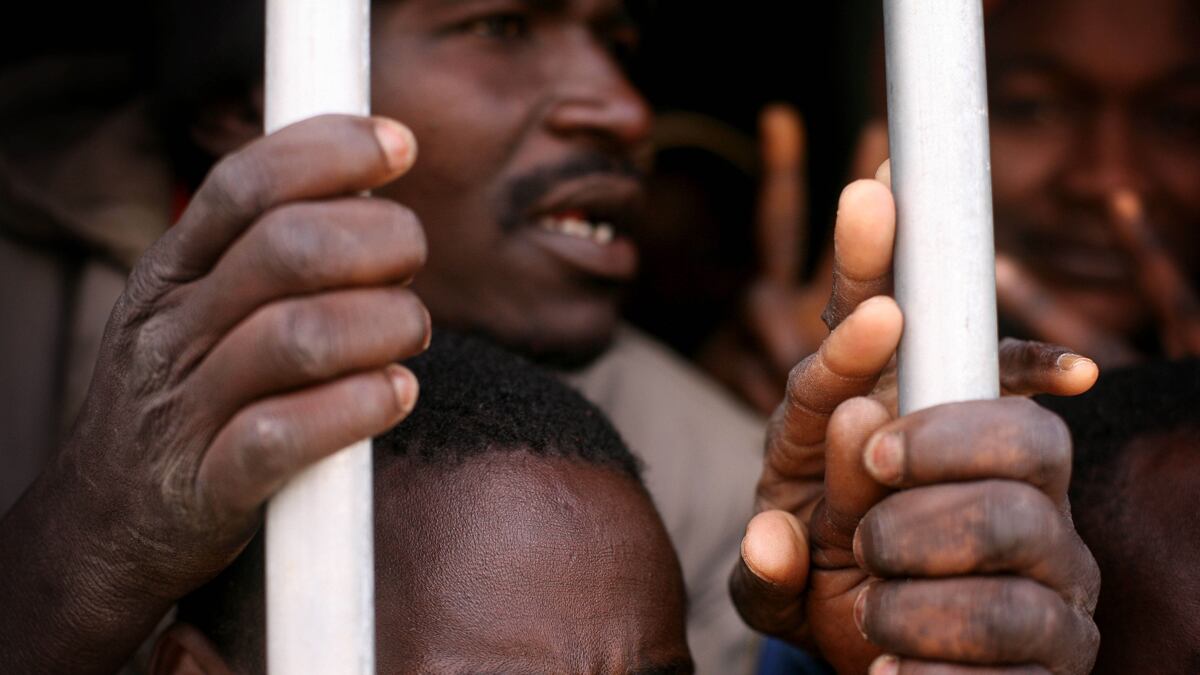Najat Taweel’s jet-black eyes fill with tears as she describes seeing her jailed brother, Abdul Taweel, shortly after his arrest. The Libyan mother of three had managed to talk her way into Tripoli’s notorious Ain Zara prison where 29-year-old Abdul was being held, charged with killing a fellow revolutionary this past February. Najat, 41, holds up photographs she says a fellow prisoner took of her brother, using a smuggled mobile phone. The pictures show a man whose back is covered with deep bruises and ugly wounds. Najat, 41, says Abdul told her he had signed a confession, but only because he couldn’t take the beatings anymore—and because his interrogators had threatened to rape and kill his family.

Libyan revolutionaries captured and killed Muammar Gaddafi more than seven months ago, but the dictator’s brutal tactics and antidemocratic ways live after him. Human-rights workers say that’s true not only within the high walls of the dictator’s former Ain Zara torture center but at other jails and penitentiaries across the country. Abdul is among at least 20 Ain Zara inmates whose relatives accuse guards of subjecting detainees to severe and regular beatings with everything from fists to sticks, metal rods, and chains. Family members say some of the prisoners have been repeatedly beaten on their genitalia, a form of punishment that—in addition to being excruciatingly painful—could leave its victims infertile. Others, according to relatives, have been tortured with Taser-style electroshock weapons.
Part of the problem may be that the country’s transitional government is only gradually managing to assert its authority over the patchwork of rival militias that overthrew the Gaddafi regime. Ain Zara remained under the control of one of those militias until less than four months ago. At the Feb. 2 handover ceremony, the facility’s new director—himself a former political prisoner at Ain Zara under the dictatorship—promised that the prison would break from its dark past and shake off its grisly reputation. “We no longer hit the detainees,” Burawi al-Guebaili declared, and he boasted of improvements such as hot meals and stalls with doors being added in the restrooms. Since then, journalists and human-rights investigators have visited the prison, but they have not been given the opportunity to speak alone with the 50 or so accused Gaddafi loyalists held there or any of the other inmates.
Najat Taweel insists her brother is innocent. She has affidavits signed by witnesses claiming he did not fire the fatal shot in a Feb. 17 gunfight between two rival militia groups in Tripoli’s Gargarish district. (Similar turf battles were a regular occurrence this past winter in the capital, and they’re not uncommon even now.) Nevertheless, Abdul was seized by judicial police soon after the shootout and taken to the state security headquarters formerly used by the Gaddafi regime. “What they are doing in Ain Zara to Abdul is inhumane,” Najat says. “I have to speak out.” She and other family members of Ain Zara inmates have dared to stage demonstrations outside the offices of the ruling National Transitional Council. The accused Gaddafi loyalists’ families are too fearful about the safety of their imprisoned relatives to join the protests.
In any case, the outcry seems to have accomplished nothing. There’s no evidence that the authorities are looking into the claims of abuses at Ain Zara, according to Amnesty International researcher Diana Eltahawi. Meanwhile, she says, the guards who have been named by the inmates’ families continue to work at the prison. Eltahawi says this isn’t unusual. “They say they will investigate and then don’t,” she says. Amnesty has documented 20 deaths in custody in Libya since August.
Officials of the transitional government insist that the only prisoner mistreatment is taking place at those detention centers outside their control. Eltahawi says she suspects that the worst abuses are occurring at those facilities—but, she says, there are problems at government prisons, too, not only at those run by militias. At least 19 other Libyan prisons remain in the hands of various militia groups that have balked at relinquishing control of them, according to General Director for Relations and International Cooperation Abdul Monem Ettunsi. Human-rights groups believe there are more. The government has listed 60 detention centers around the country, and transitional officials claim to control 30 of them. Eltahawi isn’t so sure. When she asked for a list of government-run prisons, she was supplied with a list of just eight.
Monem Ettunsi acknowledges that the official numbers may be off. “I can’t even tell you how many militias there are,” he says. “I have no idea.” The total number of detainees is likewise mysterious. Libyan authorities have estimated 8,000, but international human-rights activists believe the true figure is even higher. But the system’s flaws go far beyond such questions. Human-rights groups say the government has failed to establish clear judicial procedures until a post-Gaddafi constitution can be drafted, and arbitrary arrests continue. “Part of the problem is a lack of accountability,” Eltahawi says. “Even on the government side, the lines of authority are not clear. And the farther you get away from Tripoli, the more confused it becomes.”
The situation in Tripoli is anything but good. Najat Taweel says she has not been allowed to visit her brother in jail since that one time, more than three months ago. Other than that, she has only managed catch fleeting glimpses of him twice, when he was brought to a prosecutor’s office in central Tripoli. “He looked bad,” says Abdul’s sister. “Ghostly.”






